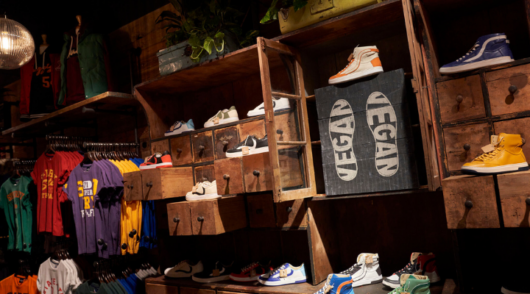True Religion is just the latest in a wave of popular, Y2K-era fashion labels experiencing a revival at the moment. The apparel brand entered the retail scene in 2002 and quickly became known for its vintage-inspired denim with wide, white stitching and recognisable smiling Buddha and horseshoe logos that were endorsed by celebrity icons such as Paris Hilton, Jessica Simpson and 50 Cent. By 2013, the company reached peak profit, when it hit $490 million in revenue, after nearly tripling sale
g sales between 2007 and 2012. It was one of the top players in the denim retail boom of the early 2000s.
However, due to factors like the rise of e-commerce, the increased availability of cheaper, “dupe” denim brands and an outdated aesthetic at a time when athleisure reigned supreme, True Religion fell off the retail grid and filed Chapter 11 bankruptcy not once but twice in 2017 and 2020.
So, what is driving the renewed consumer interest in True Religion today? One of the key players behind the brand’s resurgence is retail industry veteran Kristen D’Arcy, who previously worked at top brands including Ralph Lauren, Oscar de la Renta, Coty and Pac Sun.
Inside Retail connected with the CMO to delve into the details of True Religion’s millennial and Gen-Z-geared marketing strategy.
True Religion’s turnaround tactics
True Religion had a few tricks up its well-stitched sleeve when it came to re-introducing the brand to a previous generation of customers and presenting itself to newer shoppers.
The first major turnaround tactic was taking a step back to realise who True Religion’s ideal consumer base is today.
In the late aughts to early 2010s, the original True Religion jeans shopper was someone who bought the brand from retailers like Saks or Neiman Marcus for $200 to $300 a pair, and had an average income of $150,000 to $200,000. Today’s, True Religion shopper has an average household income of $65,000 and is much more cost-conscious.
Michael Buckley, True Religion’s president from 2006 to 2010 and its CEO as of 2019, has previously stated, “This consumer wants a deal. They’re not paying full price. Even if they love the brand, they want it at 30 per cent off, 50 per cent off. We know how to sell to them. We know how to source the product more efficiently than we did years ago…We give the customer what they want at the price they want.”
Today, True Religion’s hero product, its wide-stitch denim jeans, typically retail for approximately $150 or less, and are much more size-inclusive. As of November last year, it offered sizes from 24 to 42.
Aside from shifting its pricing and sizing tiers, True Religion recognised that today’s customers are interested in buying into not only a product but a lifestyle.
As D’Arcy told Inside Retail, “There was a realisation, especially in 2019 when Michael Buckley came back, that we can and should be a lifestyle brand.”
What does that mean exactly?
True Religion took a step back to identify the adjacent product categories, such as pet accessories and kids’ clothing, that made sense for it to enter into and how the company could authentically translate its brand into those spaces.
“What’s interesting,” D’Arcy mused, “is that when you think about a lifestyle brand is that you can outfit the whole family” in True Religion.
The increased range has so far proved fruitful for the brand. Last year, True Religion’s sales increased by about 20 per cent to reach $280 million, with approximately $80 million in earnings before interest, taxes, depreciation and amortisation.
Buckley has commented that the company plans to reach close to $500 million in revenue by 2027.
Targeting consumers with Team True
D’Arcy told Inside Retail that Team True, a content creator platform and community launched this August, has also played a major role in True Religion’s increased organic media coverage and sales turnaround this year.
Team True teammates are influential taste-makers from the sports, music and fashion industries like WNBA star Lexie Brown, filmmaker and Snoop Dogg’s son Cordell Broadus, influencer India “Love” Westbrooks and so on.
D’Arcy explained that content produced by Team True has an engagement rate that is five times the size of the brand’s regular content.
The CMO disclosed that website content created by Team True has increased the likelihood of a customer adding product to cart by over 80 per cent. She also noted that the brand has experienced upwards of $1 million in earned media value based on the reach of all of the Team True members’ posts.
D’Arcy stressed that the secret behind the success of Team True is the creators’ genuine, nostalgic connection to the brand and its products.
The CMO stated, “We work with people who have a genuine love for the brand. They have worn us before, totally independent to any marketing deal they might have made with us, 20 years ago. We’ve been around for 22 years and they’re rediscovering us now.”
What’s next in store for True Religion
At the beginning of the month, True Religion announced that it would be expanding its bricks-and-mortar portfolio with the addition of three new stores, taking the brand’s network to 51 in the US.
True Religion’s CEO Michael Buckley explained that the brand has observed “quite a bit of new demand” for the label’s products from shoppers in these markets.
“Our retail expansion strategy has always been built around our consumers,” Buckley stated.
“We know our customers in Brooklyn, San Antonio, Katy, and Orland Park will enjoy the physical shopping experience we have created for them as much as they enjoy the online experience.”
While it is still unsure if True Religion can fully return to the height of its heyday in the late aughts, it is highly interesting to see how the brand continues to reinvent itself to suit the interests of a newer generation of shoppers.







